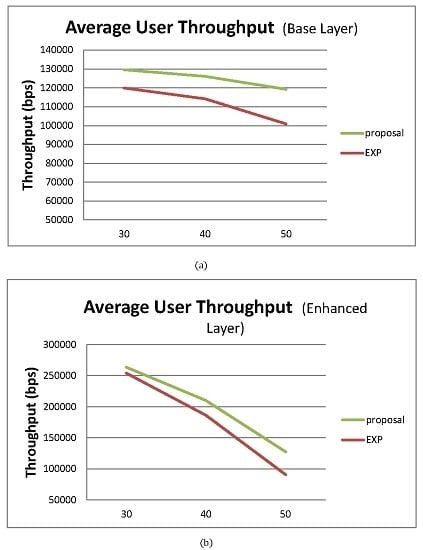A Pre-Scheduling Mechanism in LTE Handover for Streaming Video
Abstract
:1. Introduction
2. Pre-Scheduling Mechanism
2.1. Handover Prediction
2.2. Pre-Scheduling Mechanism
3. Performance Evaluation
3.1. The Effect of the Prediction Mechanism
3.2. Base Layer Adjustment
4. Conclusions
Author Contributions
Conflicts of Interest
Abbreviations
| LTE | Long Term Evolution |
| EXP/PF | exponential/proportional fair |
| 3GPP | 3rd Generation Partnership Project |
| RR | round robin |
| MR | maximum rate |
| PF | proportional fair |
| LA | link adaptation |
| M-LWDF | Maximum-Largest Weighted Delay First |
| HOL | head-of-line |
| SVC | scalable video coding |
| BL | base layer |
| ELs | enhancement layers |
| RSRP | Reference Signal Receiving Power |
| ES | exponential smoothing |
| TTT | time-to-trigger |
| LS | least squares |
| QoE | quality-of experience |
| SPS | semi-persistent scheduling |
| PRBs | physical resource blocks |
References
- Chang, M.J.; Abichar, Z.; Hsu, C.Y. WiMAX or LTE: Who will lead the broadband mobile Internet? IT Prof. Mag. 2010, 12. [Google Scholar] [CrossRef]
- Dahlman, E.; Parkvall, S.; Skold, J.; Beming, P. 3G Evolution: HSPA and LTE for Mobile Broadband; Academic press: Burlington, MA, USA, 2010. [Google Scholar]
- Kwan, R.; Leung, C.; Zhang, J. Downlink Resource Scheduling in an LTE System; INTECH Open Access Publisher: Rijeka, Croatia, 2010. [Google Scholar]
- Proebster, M.; Mueller, C.M.; Bakker, H. Adaptive Fairness Control for a Proportional Fair LTE Scheduler. In Proceedings of the IEEE 21st International Symposium on Personal Indoor and Mobile Radio Communications (PIMRC), Instanbul, Turkey, 26–30 September 2010; pp. 1504–1509.
- Andrews, M.; Kumaran, K.; Ramanan, K.; Stolyar, A.; Whiting, P.; Vijayakumar, R. Providing quality of service over a shared wireless link. IEEE Commun. Mag. 2001, 39, 150–154. [Google Scholar] [CrossRef]
- Rhee, J.H.; Holtzman, J.M.; Kim, D.K. Scheduling of Real/Non-Real Time Services: Adaptive EXP/PF Algorithm. In Proceedings of the 57th IEEE Semiannual on Vehicular Technology Conference, Jeju, Korea, 22–25 April 2003; pp. 462–466.
- Ramli, H.A.M.; Basukala, R.; Sandrasegaran, K.; Patachaianand, R. Performance of Well Known Packet Scheduling Algorithms in the Downlink 3GPP LTE System. In Proceedings of the IEEE Malaysia International Conference on Communications (MICC), Kuala Lumpur, Malaysia, 15–17 December 2009; pp. 815–820.
- Afrin, N.; Brown, J.; Khan, J.Y. An Adaptive Buffer Based Semi-persistent Scheduling Scheme for Machine-to-Machine Communications over LTE. In Proceedings of the IEEE Eighth International Conference on Next Generation Mobile Apps, Services and Technologies (NGMAST), Oxford, UK, 10–12 September 2014; pp. 260–265.
- Patra, A.; Pauli, V.; Lang, Y. Packet Scheduling for Real-Time Communication over LTE Systems. In Proceedings of the IEEE Wireless Days (WD), Valencia, Spain, 13–15 November 2013; pp. 1–6.
- Piro, G.; Grieco, L.A.; Boggia, G.; Fortuna, R.; Camarda, P. Two-level downlink scheduling for real-time multimedia services in LTE networks. IEEE Trans. Multimed. 2011, 13, 1052–1065. [Google Scholar] [CrossRef]
- Xenakis, D.; Passas, N.; Merakos, L.; Verikoukis, C. ARCHON: An ANDSF-Assisted Energy-Efficient Vertical Handover Decision Algorithm for the Heterogeneous IEEE 802.11/LTE-Advanced Network. In Proceedings of the IEEE International Conference on Communications (ICC), Sydney, Australia, 10–14 June 2014; pp. 3166–3171.
- Xenakis, D.; Passas, N.; Verikoukis, C. A Novel Handover Decision Policy for Reducing Power Transmissions in the Two-Tier LTE Network. In Proceedings of the IEEE International Conference on the Communications (ICC), Ottawa, ON, Canada, 10–15 June 2012; pp. 1352–1356.
- Xenakis, D.; Passas, N.; Merakos, L.; Verikoukis, C. Mobility management for femtocells in LTE-advanced: Key aspects and survey of handover decision algorithms. IEEE Commun. Surv. Tutor. 2014, 16, 64–91. [Google Scholar] [CrossRef]
- Xenakis, D.; Passas, N.; Gregorio, L.D.; Verikoukis, C. A Context-Aware Vertical Handover Framework towards Energy-Efficiency. In Proceedings of the IEEE 73rd Vehicular Technology Conference (VTC Spring), Yokohama, Japan, 15–18 May 2011; pp. 1–5.
- Xenakis, D.; Passas, N.; Merakos, L.; Verikoukis, C. Energy-Efficient and Interference-Aware Handover Decision for the LTE-Advanced Femtocell Network. In Proceedings of the IEEE International Conference on Communications (ICC), Budapest, Hungary, 9–13 June 2013; pp. 2464–2468.
- Mesodiakaki, A.; Adelantado, F.; Alonso, L.; Verikoukis, C. Energy-efficient user association in cognitive heterogeneous networks. IEEE Commun. Mag. 2014, 52, 22–29. [Google Scholar] [CrossRef]
- LTE Simulator. Available online: http://telematics.poliba.it/LTE-Sim (accessed on 12 January 2015).
- Video Trace Library. Available online: http://trace.eas.asu.edu/ (accessed on 15 February 2015).












| Parameter | Values |
|---|---|
| Simulation Time | 100 s |
| Simulation Rounds | 100 |
| Cell Radius | 1 km |
| Number of User Equipments (Ues) (per cell) | 30, 40, 50 |
| Velocity of UEs (km/h) | 30, 120 |
| UE Application Flows | Video Application |
| Modulation and Coding Scheme | QPSK, 16QAM, 64QAM |
| Number of Cells | 7 |
| Number of eNodeB | 7 |
| Bandwidth | 10 MHz |
| Number of PRBs | 50 (12 Subcarriers/PRB) |
| Transmission Time Interval | 0.5 ms/slot |
| 1 ms/subframe | |
| 10 ms radio frame/TTI | |
| Mobility Model of UEs | Random Direction |
© 2016 by the authors; licensee MDPI, Basel, Switzerland. This article is an open access article distributed under the terms and conditions of the Creative Commons by Attribution (CC-BY) license (http://creativecommons.org/licenses/by/4.0/).
Share and Cite
Lai, W.-K.; Tai, C.-K.; Su, W.-M. A Pre-Scheduling Mechanism in LTE Handover for Streaming Video. Appl. Sci. 2016, 6, 88. https://doi.org/10.3390/app6030088
Lai W-K, Tai C-K, Su W-M. A Pre-Scheduling Mechanism in LTE Handover for Streaming Video. Applied Sciences. 2016; 6(3):88. https://doi.org/10.3390/app6030088
Chicago/Turabian StyleLai, Wei-Kuang, Chih-Kun Tai, and Wei-Ming Su. 2016. "A Pre-Scheduling Mechanism in LTE Handover for Streaming Video" Applied Sciences 6, no. 3: 88. https://doi.org/10.3390/app6030088







